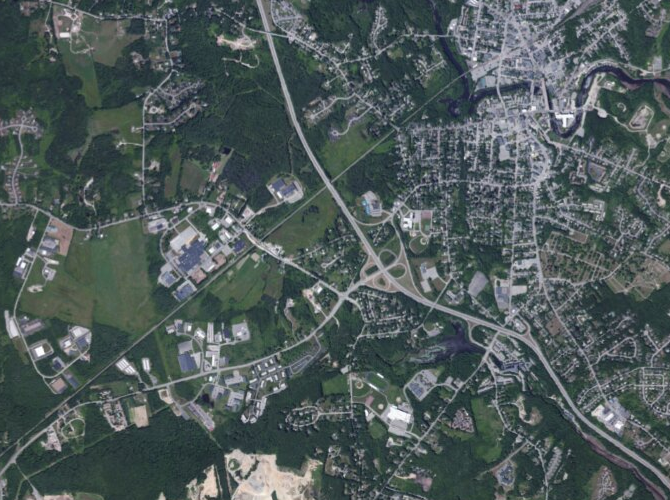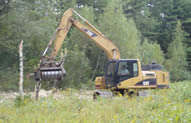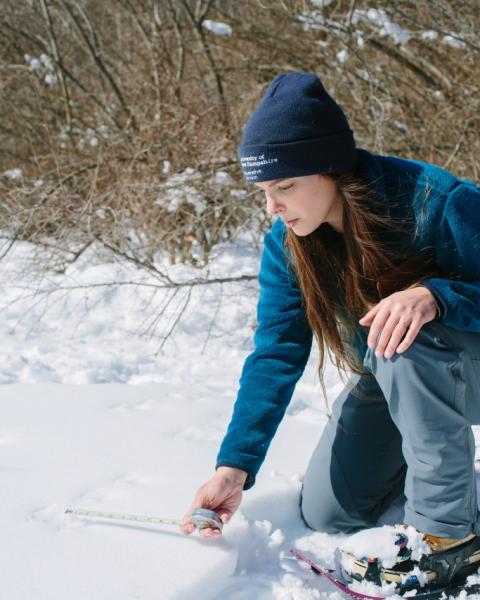Shrubland habitats contain thickets of shrubs and young trees mixed with scattered grasses and wildflowers. Large shrublands--those greater than 5 acres--are relatively rare in New Hampshire.
Typical plants include dogwood, alder, Viburnum, pincherry, and many other species.
Shrubland habitats are almost always temporary, existing on the land for a relatively short period of time. New Hampshire’s climate and soils are especially suitable for growing trees. If an open field is left alone, unmowed, for just a few years, shrubs and young trees will start to grow. As the trees grow, they shade out grasses, wildflowers and shrubs. Within twenty-five to thirty years, the area that was once a field will become a young forest. This process of vegetation change over time is called succession. Old fields, shrublands, and young forests, often called early-successional habitats, are becoming increasingly uncommon in our state.
Where are Shrublands Found?
Most large shrublands in New Hampshire are found on old fields and pastures, powerline corridors, gravel pits, and in recent clearcuts. These shrublands exist as a result of human activities—through mowing, tree cutting, or abandonment of agricultural fields. Naturally-occurring shrublands also exist on the landscape.
Learn about new Extension Research on Shrublands: exotic shrubs, powerlines, and habitat for shrubland-nesting birds.
Abandoned beaver ponds grow into shrublands that may last for twenty or more years after the beavers are gone and the water has drained from the pond. Other natural shrublands include wet shrub swamps, patches of juniper, and very dry oak barrens, which, under natural conditions, are kept shrubby by periodic fires. These natural shrublands may remain open for thirty or more years, but in the absence of additional natural disturbance, these too will revert to forest.
 Why are Shrublands Important?
Why are Shrublands Important?
Impenetrable and dense, shrublands are often ignored and undervalued by people. For some species of wildlife, such as New England cottontail rabbits, American woodcock, and ruffed grouse, shrublands provide the best possible cover. The shrubs and young trees growing in these areas also provide an abundance of berries and fruit, eaten by many different birds and mammals.
Shrublands exist in patches throughout the state, but most are difficult to recognize on traditional satellite imagery, so their total expanse in the state is unknown. However, changes in land use (see below) mean that we have lost virtually all of the shrubland habitat that existed in the state throughout the last century.
Declines in Shrubland Habitat
Over the past 100 years, there has been a dramatic decrease in the amount of shrubland in New Hampshire. Land-use change, human development, fewer large beaver impoundments, and fire suppression have led to a decline in many wildlife species that depend on shrublands. Twenty-two of our forty shrubland bird species show population declines. Shrub-dependent New England cottontails occur in less than 25% of their historic range, and are now listed as an endangered species in New Hampshire.
Succession of farmland
The late 1800s and early 1900s saw a widespread abandonment of farmlands in New Hampshire. As fields went unmowed, shrubland habitats grew in their place, becoming common across the state. During this time, wildlife that depend on shrublands also increased. American woodcock, golden-winged warbler, eastern towhee and brown thrasher all thrived in the abundance of dense shrubby cover. By the latter part of the 20th century, most of these abandoned fields had reverted to the forests we see today, and the wildlife associated with shrublands also declined dramatically.
 Threats from development
Threats from development
Human development poses a severe risk to shrubland habitats, because the alterations caused by buildings and roads are irreversible. Development also fragments existing shrubland communities, limiting the types of wildlife that can use these smaller habitat patches. Research has shown that some species, such as New England cottontail, cannot survive in shrublands that are near development or along powerlines because of the increased predation from hawks, owls, foxes, and coyotes. New England cottontails need large areas of thickets (more than 5 acres), and will do best in areas away from dense human settlement.
Maintenance costs
In today’s landscape, small areas of shrublands may be created naturally—for example, by beaver dam abandonment or small fires. However, most wildlife biologists agree that to sustain wildlife species that depend on shrublands, additional management to create shrubland habitat is needed. Maintaining large areas of existing shrubland may cost money and provide little economic return to landowners. Many federal and state cost-share programs address this problem by providing financial assistance to landowners to create or maintain early successional habitats and shrublands (click here for cost-share options). Another management option is to create early-successional habitat as part of planned timber management, creating temporary openings paid for by timber revenue.
Climate Vulnerabilities for Shrublands
- In general these habitats are currently believed resistant to climate change as long as management continues.
- Increased diversity and abundance of invasives (particularly plants).
- Potential for loss of wildlife value to these habitats from intensified management resulting from a longer growing season and an increased demand for biomass fuels.
Click here for the Early Successional Climate Assessment, a section of the Ecosystems and Wildlife Climate Change Adaptation Plan (2013), an Amendment to the NH Wildlife Action Plan
Wildlife Found in Shrublands
Many wildlife species use shrublands, including those listed below. Be on the lookout for these species, and follow stewardship guidelines to help maintain and enhance these habitats. Species of conservation concern--those wildlife species identified in the Wildlife Action Plan as having the greatest need of conservation--appear in bold typeface, with links to their species profile from the Plan.
| American bittern | American woodcock | Black bear |
| Black racer* | Bobcat | Canada lynx*** |
| Eastern box turtle | Eastern hognose snake** | Eastern towhee |
| Golden-winged warbler | Moose | New England cottontail** |
| Northern harrier** | Purple finch | Ruffed grouse |
| Smooth green snake | Timber rattlesnake** | Whip-poor-will |
| Whitetail deer | Wood turtle | |
| *state-threatened species | **state-endangered species |
***state-endangered, federally threatened |
Stewardship Guidelines for Shrublands Habitat
Help spread the word to neighbors and land managers about the importance of shrublands to wildlife. Landowners can take steps to help conserve these habitats on their lands:
Maintain Existing Shrubland Habitat
 Natural processes can help maintain shrubland habitats. Allowing for the natural abandonment of beaver dams, and where possible, use of prescribed fire will help maintain some shrubland habitats.
Natural processes can help maintain shrubland habitats. Allowing for the natural abandonment of beaver dams, and where possible, use of prescribed fire will help maintain some shrubland habitats.- Larger shrublands (>5 acres) provide a better buffer against predation than smaller ones. Focus conservation on large patches of shrublands as opposed to smaller or isolated patches.
- Shrublands with wetter soils are highly valuable. Vegetation is denser here, providing the thickest cover for such species as New England cottontail rabbits and black racer snakes. American woodcock also use wet shrublands, searching the moist soil for earthworms.
- Consult with a professional to help identify large areas of dense shrub habitat (5+ acres) which can be maintained by periodic cutting of small patches over time. Federal and state cost-share programs can help fund these projects, and landowners can get free technical assistance from UNH Cooperative Extension to plan projects such as:
- Mowing or brush-hogging different sections every 3-5 years
- Cutting sections every 5-10 years (may require use of heavy equipment such as a "brontosaurus” type mower)
- Using prescribed fire
- Even though invasive shrubs such as multiflora rose and common buckhorn may provide suitable cover for wildlife, these aggressive plants can cause other ecological problems and should be discouraged.
- All known locations of New England cottontails in New Hampshire occur on private lands. The survival of this endangered species relies on the cooperation of private landowners willing to create and maintain habitat. For information about New England cottontail conservation and habitat management, consult the publication “New England Cottontail Rabbits in New Hampshire,” available from UNH Cooperative Extension or NH Fish & Game.
Create New Shrubland Habitat
- Landowners can get free technical assistance through UNH Cooperative Extension to help create early-successional habitats on their land. It is critical to identify appropriate locations for new early-successional habitats to avoid damage to sensitive species, waterbodies, or habitats that can be affected by mowing or cutting trees.
- New openings for shrubland habitat should be located near existing thickets, such as on the edges of powerline corridors or near shrub wetlands.
- Whenever possible, encourage shrubs to grow naturally. Planting is expensive and susceptible to heavy browsing by deer.
- Even small patches of early-successional habitat can be valuable to wildlife. Allowing the edges of fields to become shrubby, thus “softening” the edge between field and forest, is an easy way to create early-successional habitat around open fields. Shrub borders at least 20 feet wide will provide habitat for a variety of wildlife species.
Land Conservation with Management Provisions
- Minimizing future habitat loss in areas with natural or maintained shrublands will be critical for conserving shrubland-dependent wildlife. Putting your land into a conservation easement will ensure that it will never be developed.
- To permanently conserve shrubland habitat, conservation easements should contain legal provisions and a long-term funding source for management.
Additional Resources on Shrublands
- NH Wildlife Action Plan habitat profile for Shrublands, click here for information about the condition and location of this shrublands, the threats facing this habitat, and conservation actions recommended by biologists to protect shrublands.
- Making Habitat Happen - a guide to managing shrublands
- Managing Grasslands, Shrublands, and Young Forest Habitats for Wildlife: A Guide for the Northeast - for technical guidance on managing open areas for wildlife, check out this online guide from NH Fish & Game
- New England Cottontail Rabbits
- The Young Forest Project
Photo Credits on this page: Emma Carcagno, Pam Hunt, Malin Clyde, Jim Panaccione.
Research for this webpage and accompanying Habitat Stewardship Brochures was conducted by UNH Cooperative Extension staff with support from the Sustainable Forestry Initiative and NH Fish & Game
